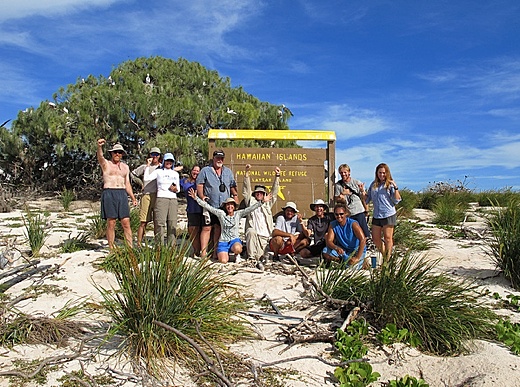 Image above: Millerbird in release cage just before being set free on Laysan Island. From (http://www.flickr.com/photos/usfwspacific/6163830543/in/photostream/).
Image above: Millerbird in release cage just before being set free on Laysan Island. From (http://www.flickr.com/photos/usfwspacific/6163830543/in/photostream/).
A second group of Nihoa millerbirds has been successfully moved from Nihoa to Laysan—both islands in the northwestern end of the Hawaiian archipelago.
The movement assures the species of a second breeding population, improving its potential for survival.
Biologists collected, shipped by boat from Nihoa to Laysan, and released 26 millerbirds in mid-August, in a joint effort of the U.S. Fish and Wildlife Service (FWS), American Bird Conservancy (ABC), and other organizations. Twenty-four millerbirds were moved to the island in 2011, and those first birds have already produced 17 chicks.
“So far, everything has gone extremely well for the birds,” said millerbird expert and University of Hawai`i biologist Sheila Conant. “They were captured without incident; they made it through the boat ride in good health; we had no problems attaching transmitters to them; and they have now been released to their new habitat without a hitch. So we are thrilled with the way this phase has gone.”
 Image above: Team pose for photo after successfulmillerbird release on Laysan Island. From (http://www.flickr.com/photos/usfwspacific/6163830543/in/photostream/).
Image above: Team pose for photo after successfulmillerbird release on Laysan Island. From (http://www.flickr.com/photos/usfwspacific/6163830543/in/photostream/).
Millerbirds eat insects. The little (one-ounce) birds forage in the low shrubs and bunchgrasses of the islands. They are relatives of a class of birds known as old world warblers. BirdLife International has more information here.
This species is not new to Laysan. A subspecies, the Laysan millerbird, existed on Laysan until introduced rabbits helped denude the island of much of its vegetation, and the habitat destruction killed off the birds. Laysan’s rabbits have long since been removed and the native vegetation is being restored.
Scientists are assuming that the 50 birds translocated in the 2011 and 2012 projects will provide a sufficient founder population to allow a healthy self-sustaining population to develop, said Don Palawski, Acting Fish and Wildlife Service Superintendent of the Papahānaumokuākea Marine National Monument, which encompasses the Northwestern Hawaiian Islands.
Work during the first year of Nihoa millerbird presence on Laysan suggests that the habitat is appropriate for them, and there is sufficient food.
Laysan is an extremely isolated island, without an airfield or harbor. Researchers arrive at the island on small boats from research vessels anchored offshore. Winter access is generally not possible due to surf, but one researcher will remain on the island through the winter season to keep tabs on the birds.
The Fish and Wildlife Service web page on its millerbirdwork is here.
See also:
Ea O Ka Aina: Nihoa Millerbirds 8/10/12
.
No comments :
Post a Comment